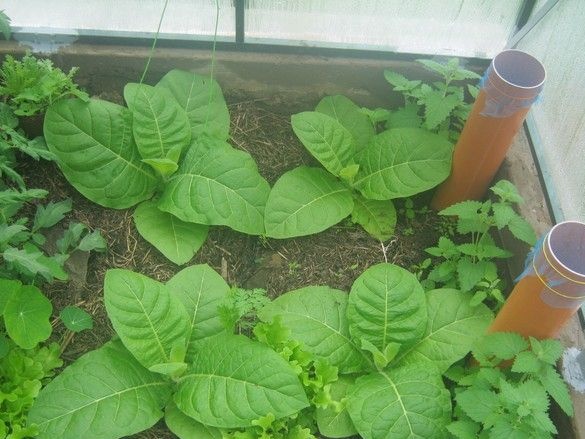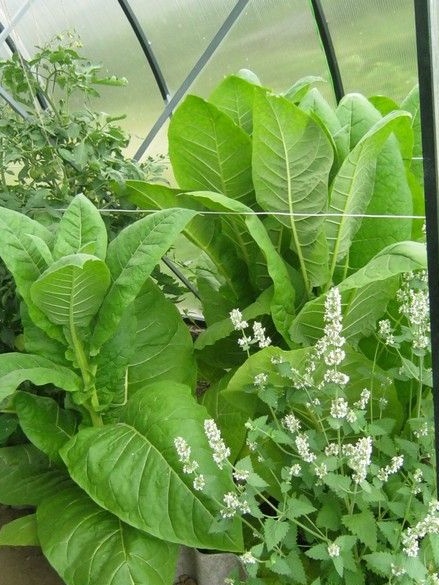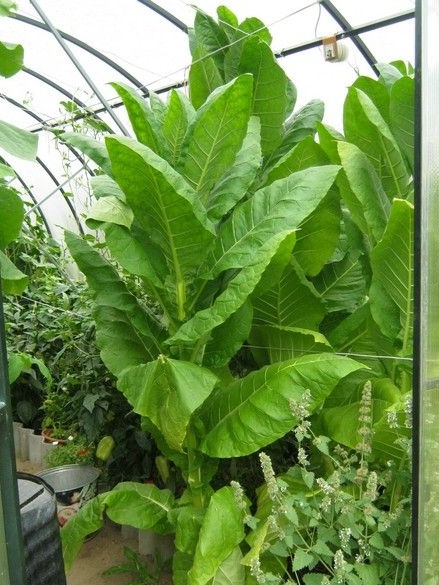
Do not count experiments on the effect of electric current on plants. Even I.V. Michurin conducted experiments in which hybrid seedlings were grown in large boxes with soil through which direct current was passed. It was found that seedling growth is enhanced. In experiments conducted by other researchers, variegated results were obtained. In some cases, the plants died, in others they gave an unprecedented harvest. So, in one of the experiments around the plot where carrots grew, metal electrodes were inserted into the soil, through which an electric current was passed from time to time. The crop exceeded all expectations - the mass of individual roots reached five kilograms! However, subsequent experiments, unfortunately, gave different results. Apparently, the researchers overlooked some condition that made it possible to obtain an unprecedented yield in the first experiment using electric current.
The essence of the experiments - osmotic processes in the roots are stimulated, the root system grows larger and more powerful, and accordingly the plant. Sometimes they still try to stimulate the process of photosynthesis.
The currents are usually microampere, the voltage is not too important, usually fractions of volts ... volts. As a power source, they use galvanic cells - at operating currents, the capacity of even small batteries lasts a very long time. Nutrition parameters are well suited for solar cells, and some authors recommend that they be powered from them, so that stimulation occurs synchronously with solar activity.
However, there are also methods of electrifying the soil that do not use external sources of energy.
So, the method proposed by French researchers is known. They patented a device that works like an electric battery. Only as an electrolyte is a soil solution used. To do this, positive and negative electrodes (in the form of two combs, the teeth of which are located between each other) are alternately placed in its soil. The conclusions from them are short-circuited, thereby causing the heating of the electrolyte. Between the electrolytes, a current of low power begins to pass, which is quite enough, as the authors convince, to stimulate the accelerated germination of plants and their accelerated growth in the future.The method can be used both on large sown areas, fields, and for electrical stimulation of individual plants.
Another method of electrical stimulation was proposed by employees of the Moscow Agricultural Academy. Timiryazev. It consists in the fact that strips are located within the arable layer, in some of which the elements of mineral nutrition in the form of anions predominate, in others - cations. The potential difference created at the same time stimulates the growth and development of plants, increases their productivity.
It should be noted another way of electrifying the soil without an external current source. To create electrolyzable agronomic fields, it involves the use of the electromagnetic field of the Earth, for this they are laid at a shallow depth, so as not to interfere with the usual agronomic work, along the beds, between them, after a certain interval of the steel wire. At the same time, a small EMF of 25-35 mV is induced on such electrodes.
In the experiment described below, an external power source is still used. Solar battery. Such a scheme, which may be less convenient and more expensive in terms of materials, nevertheless, makes it possible to very clearly monitor the dependence of plant growth on various factors, has synchronous activity with the sun, probably more pleasant for the plant. In addition, it makes it easy to control and regulate the impact. Does not imply the introduction of additional chemicals into the soil.
So. What was used.
Materials
Installation wire, any section, but too thin will be vulnerable to accidental mechanical stress. A piece of stainless steel for electrodes. LEDs for solar cells, a piece of foil material for its base. Chemicals for pickling, but you can do it. Acrylic lacquer. Microammeter. A piece of sheet steel for fixing it. Related trifles, fasteners.
Tool.
A set of bench tools, a 65W soldering iron with accessories, a tool for radio mounting, something for drilling, including holes for the LED leads (~ 1mm). Glass drawing pen for drawing tracks on the board, but you can get by with a thick needle from the syringe, an empty ampoule from a ballpoint pen with a softened and drawn nose. My favorite tool was also useful - a jewelry jigsaw. A bit of accuracy.
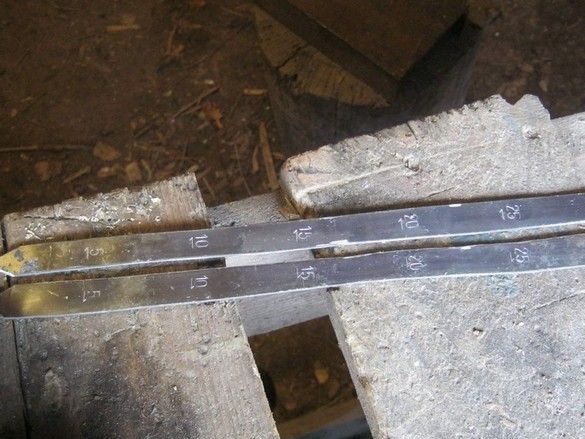
The electrodes are stainless steel. Marked, sawed, sawn off burrs. Marks of the depth of immersion, this is perhaps unnecessary - I recently acquired a set of stamps with digits and my hands itched to try.
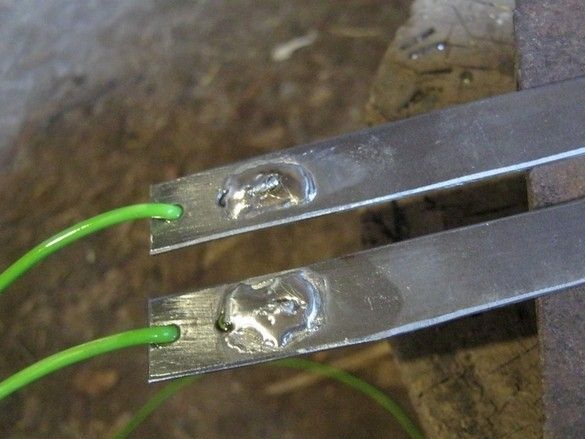
The wires were soldered with zinc chloride (soldering acid flux) and the usual POS-60. The wires took thicker with silicone insulation.
It was decided to make a solar cell on their own. There are several designs of homemade solar cells. An element of copper oxide was rejected as low reliability, there was an option from the finished radio elements. It was a pity, a long and dreary to open diodes and transistors in metal cases, besides they will have to be sealed again later. In this sense, it’s a miracle how good LEDs are. The crystal is flooded to death with a transparent compound, although it will work under water. There was just a handful of not-so-convenient LEDs purchased for nothing on the occasion, even during the “initial accumulation of capital”. They are inconvenient, with a relatively weak glow and a very telephoto lens at the end. The angle of the field of view is rather narrow and from the side, and in the light, sometimes it’s not even visible what is glowing. Well, one of them scored a battery.
Previously, of course, after conducting a series of simple experiments, I connected it to the tester and turned around on the street, in the shade, in the sun. The results seemed quite encouraging. Yes, it should be remembered that if you connect the multimeter simply to the legs of the LED, the results will not be particularly reliable - such a photocell will work on the input resistance of the voltmeter, and with modern digital devices it is very high. In a real scheme, the indicators will not be so brilliant.

Blank for PCB. The battery was intended for installation inside the greenhouse, the microclimate there, sometimes quite humid. Large openings, for better "ventilation" and draining of possible drops of water.It should be said that fiberglass is a very abrasive material, drills become dull very quickly, and small ones, if drilled with a hand tool, also break. You need to buy them with a margin.
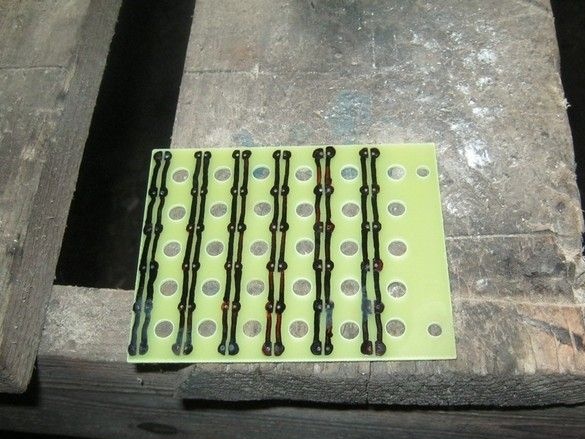
The circuit board is painted with bitumen varnish, etched in ferric chloride.
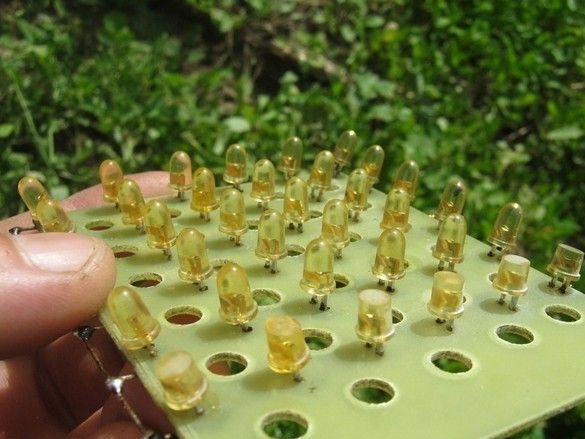
LEDs on the scarf, switching on in parallel-serial.

The LEDs are bent somewhat to the sides, from east to west, so that the current is generated more evenly during daylight hours.
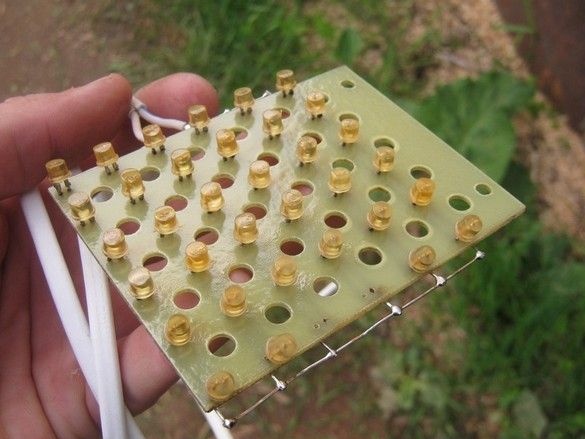
LED lenses are sharpened to eliminate directivity. Everything under three layers of varnish, however, urethane, as expected, was not found, it was acrylic.
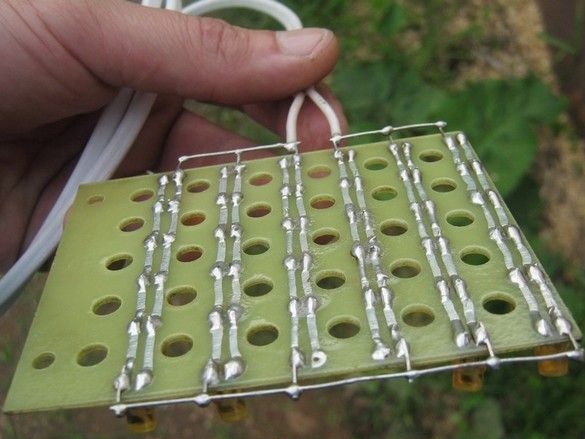

I cut and bent the mount for the microammeter in place. He cut out the seat with a jewelry jigsaw. Painted from a spray can.
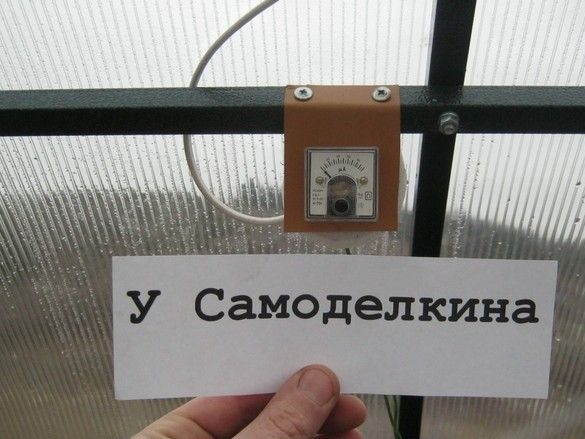
Well, installation at the facility.
Microammeter in chain, on bracket, at eye level. But how to understand that the wires are all intact, nothing fell off anywhere? And here it means, you look at him, and he tells you, “Everything is all right Comrade General, there are no incidents, we mean we are serving, we look into the future with cautious optimism ...”

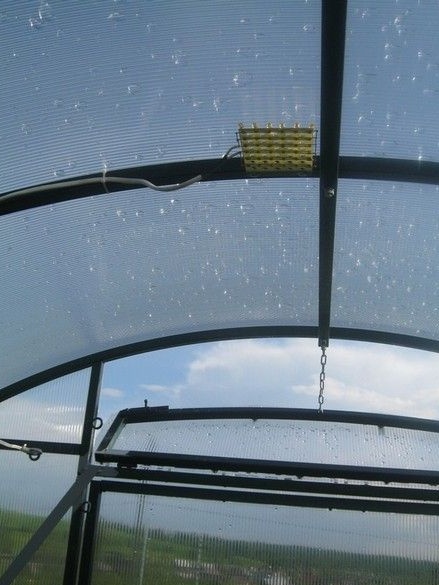

Subject is Walkers Broadleaf sapling. About a quarter of a volt under load. In the evening.
Now, summer later, I can summarize - the method works, but the results are not outstanding - the experimental plant was 10 ... 15% larger than its neighbors, it bloomed earlier by 4 ... 5 days. The current reached 35 ... 38 μA, which is a bit too much. In the literature, there were recommendations of American tobacco growers experimenting with electrical stimulation, they advised to pass about 20 μA through the plant. It was possible to reduce the current by turning on the variable resistor in the circuit, or by slightly obscuring the solar battery. Next season we’ll try on tomatoes, it seems not worth growing tobacco in a greenhouse.
